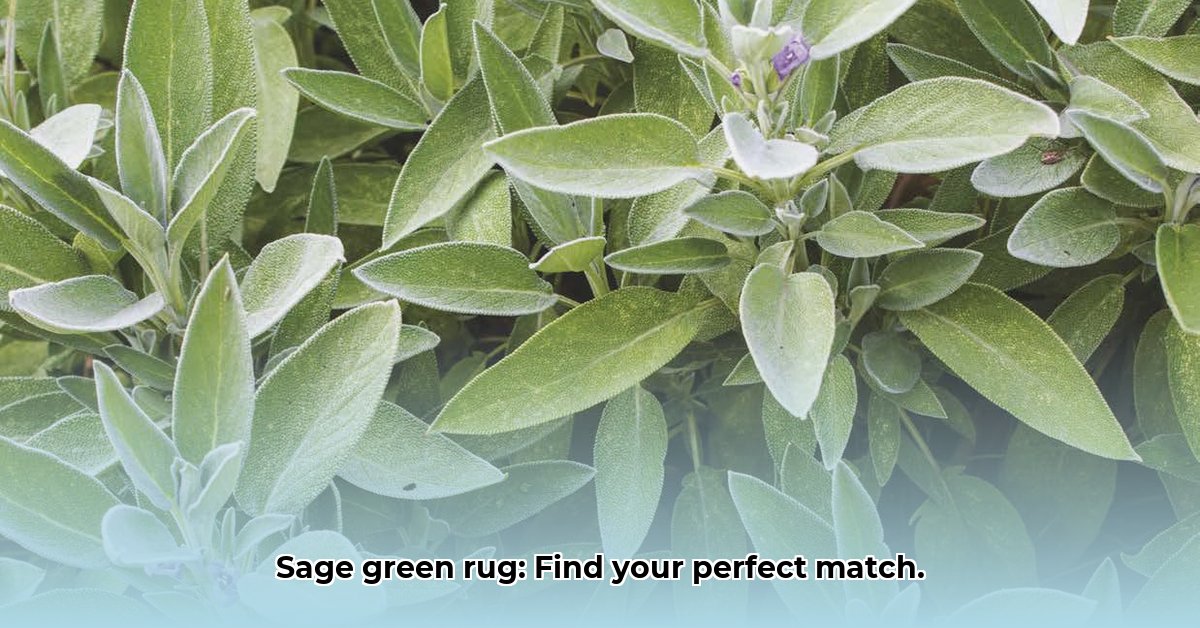Infuse your home with the calming elegance of a sage green rug. This guide simplifies your selection, offering actionable insights to discover the ideal rug for your space. We’ll explore color variations, materials, sizes, styles, ethical sourcing, and care, empowering you to make an informed and satisfying purchase. For more color options, check out these gorgeous rugs.
Choosing the Right Sage Green Rug
Sage green rugs bring a serene and versatile touch to any room, complementing various décor styles from modern to farmhouse. Navigate the choices and select a rug that elevates your home with confidence.
Understanding Sage Green Hues and Undertones
Sage green encompasses a spectrum of shades, from light, washed-out tones to deeper, olive-infused variations. Some lean towards cool grays, while others exhibit warmer, yellowish undertones.
- Cool Sage Green: Complements modern spaces with gray or blue undertones.
- Warm Sage Green: Suits farmhouse and traditional aesthetics with yellow or beige undertones.
- Olive-Infused Sage: Offers a sophisticated, earthy feel, working well in transitional designs.
Consider natural and artificial lighting in your room. A rug might appear different in-store versus in your home. Obtain samples or utilize online visualization tools to accurately assess color in your space.
Material Matters: Rug Construction and Fiber Characteristics
The material of your rug significantly affects its durability, feel, maintenance, and price. Understanding fiber characteristics is essential.
- Wool: A luxurious, durable, and naturally stain-resistant option that can last for decades with proper care. Wool rugs offer excellent insulation and a soft feel underfoot. However, they often require professional cleaning and can be more expensive. Ideal for living rooms and bedrooms.
- Cotton: A softer and more affordable natural fiber than wool. Cotton rugs are breathable and relatively easy to clean, making them suitable for casual spaces. However, they are less durable and may not withstand high-traffic areas. Consider cotton rugs for bedrooms or low-traffic living spaces.
- Synthetic Fibers: Budget-friendly options like polyester, polypropylene (olefin), and viscose (rayon). These rugs are stain-resistant and easy to clean, making them suitable for households with pets or children. However, they often lack the luxurious feel and longevity of natural fibers. Ideal for entryways, kitchens, and playrooms.
- Jute and Sisal: Natural plant fibers offering a textured, rustic look. Jute is softer than sisal, but both are durable and relatively affordable. These rugs are best suited for low-moisture areas, as they can be susceptible to water damage. Consider jute or sisal for living rooms, dining rooms, or covered outdoor spaces.
- Silk: A luxurious and delicate fiber with a shimmering appearance. Silk rugs are incredibly soft and add a touch of elegance to any room. However, they are expensive and require professional cleaning. Best suited for low-traffic areas like master bedrooms or formal living rooms.
Ethical and Sustainability Considerations: Seek certifications like Fair Trade, GOTS (Global Organic Textile Standard), or Oeko-Tex, indicating sustainable and ethical practices. Research the rug’s origin and manufacturing processes. Consider rugs made from recycled materials, such as recycled plastic bottles, to minimize environmental impact.
Finding the Right Rug Dimensions: Space Planning Guidelines
Proper sizing is crucial for visual harmony. A too-small rug appears lost, while a too-large rug overwhelms the room.
- Living Room: Extend the rug a few feet beyond your furniture, allowing all legs of your seating (or at least the front legs) to rest on it. In smaller spaces, the rug can float in the center, defining the seating area without touching the walls.
- Bedroom: Extend the rug at least partially under the bed, with additional extension on either side. A popular approach is to place the rug under the bottom two-thirds of the bed. Alternatively, use smaller rugs on either side of the bed for a more minimalist look.
- Dining Room: Ensure the rug accommodates all chairs when pulled out from the table. Add at least 24-36 inches to the table’s dimensions to determine the minimum rug size.
Use painter’s tape to mark the rug’s dimensions on your floor before purchasing. Online room planners and augmented reality apps can also help visualize rug placement.
Design Styles to Incorporate: Harmonizing with Your Décor
Sage green rugs are incredibly versatile.
- Bohemian: Pair with textured throw pillows, vibrant tapestries, globally inspired décor, and eclectic furniture. Layer rugs for added texture and visual interest.
- Farmhouse: Combine with natural wood furniture, shiplap walls, vintage accents, and rustic décor. A distressed sage green rug enhances the farmhouse aesthetic.
- Minimalist: A neutral sage green rug grounds a minimalist space, adding warmth without overwhelming clean lines. Choose a rug with a subtle texture or pattern for added depth.
- Transitional: Seamlessly bridges traditional and modern styles, adding sophistication and subtle color. Pair with classic furniture silhouettes and contemporary accessories.
- Coastal: Evokes a calming, beachy vibe when paired with light woods, white linens, and nautical-inspired accents. A sage green rug with a subtle wave pattern can enhance the coastal theme.
- Contemporary: Enhances modern spaces with clean lines, geometric patterns, and bold accents. Pair a sage green rug with furniture in neutral tones and pops of color for a balanced look.
Browse online platforms like Pinterest and Houzz for inspiration. Experiment with different combinations using mood boards or virtual design tools.
Retailers to Explore: Finding the Perfect Source
Choose from big box stores, online marketplaces, specialty home décor stores, and artisan boutiques.
- Online Retailers: Offer a wide selection and competitive prices. Carefully read customer reviews, check return policies, and verify shipping costs. Look for retailers offering free returns or virtual try-on tools.
- Brick-and-Mortar Stores: Allow you to physically examine texture, quality, and color accuracy. Ensure the store has a knowledgeable staff who can provide guidance. Consider local rug stores or design showrooms for unique options.
- Specialty Home Décor Stores: Curated collections and personalized service.
- Artisan Boutiques: Unique, hand-crafted rugs; support local artisans and ethical production.
Prioritize retailers providing detailed product information, including materials, origin, construction, care instructions, and certifications.
Rug Care: Best Practices for Longevity
Proper care extends your rug’s lifespan and maintains its beauty.
- Regular Vacuuming: Prevent dirt buildup, especially in high-traffic areas. Vacuum at least once a week, using a vacuum cleaner with adjustable height settings.
- Spot Cleaning: Blot spills immediately with a clean, white cloth, working from the outside in. Use a pH-neutral rug cleaner specifically designed for your rug’s material. Test the cleaner in an inconspicuous area first.
- Professional Cleaning: Maintain freshness and remove deep-seated dirt periodically. Schedule professional cleaning every 12-18 months, depending on traffic and usage.
- Rotate Your Rug: Even out wear and prevent fading by rotating your rug every 6-12 months.
- Use Rug Pads: Protect your floors, prevent slipping, and add cushioning. Choose a rug pad made from natural rubber or felt.
Always follow the manufacturer’s care instructions.
Sustainability: Environmentally Conscious Rug Choices
Choosing a sustainably made rug reduces your environmental impact.
- Recycled Materials: Opt for rugs made from recycled plastic bottles (PET) or reclaimed fibers.
- Natural and Renewable Fibers: Choose rugs made from wool, cotton, jute, sisal, or bamboo. Look for certifications like GOTS (Global Organic Textile Standard) for organic cotton.
- Low-VOC Dyes and Adhesives: Ensure the rug is made with non-toxic dyes and adhesives to minimize off-gassing.
- Handcrafted Rugs: Support traditional craftsmanship and reduce reliance on mass production.
- Ethical Production: Look for rugs made in factories that provide fair wages and safe working conditions.
Research thoroughly to be an informed shopper and support brands committed to sustainability.
Conclusion: Embark on Your Rug Journey
Purchasing a sage green rug enhances your home’s aesthetic and comfort, so consider shade, material, size, style, ethical sourcing, and care. Thorough research ensures a beautiful and ethical purchase that will complement your space for years.
How to Choose a Sustainable Sage Green Area Rug: Eco-Conscious Decor
Here’s how to choose a sustainable sage green area rug.
Key Takeaways:
- Sage green rugs offer versatile style, complementing various décor.
- Sustainability depends on material (natural fibers, recycled content), production (handcrafted vs. mass-produced), and longevity.
- Transparency and ethical sourcing from manufacturers are crucial.
Deeper Dive: Understanding Your Sage Green Shade and Undertones
Shades range from muted olives to bright, almost teal hues. Do you prefer cool or warm undertones? A pale sage might soften a bold room, while a deeper shade could anchor a neutral space. Finding the perfect match is key. Use color wheels and online tools to explore complementary colors and undertones.
Material Exploration: Choosing Eco-Friendly Fibers
Rug materials greatly impact sustainability.
Natural Fibers:
- Wool: Durable, naturally stain-resistant and biodegradable. Look for Responsibly Wool Standard (RWS) certified wool.
- Cotton: Soft, breathable, and relatively affordable. Opt for organically grown cotton whenever possible
- White On White Kitchen Backsplash: Is It Timeless? - November 20, 2025
- Backsplash Colors for White Cabinets: Find Your Perfect Match - November 19, 2025
- Backsplash Ideas for White Cabinets: Find Your Perfect Style - November 18, 2025










